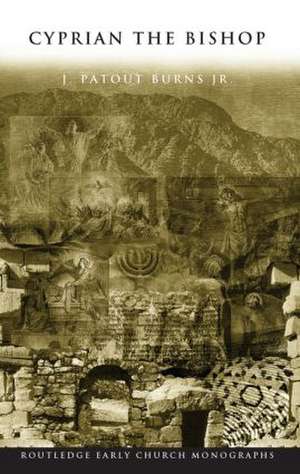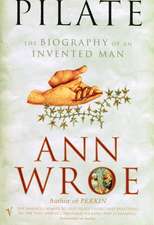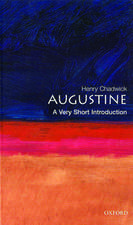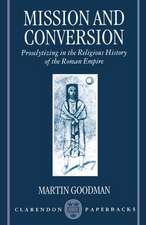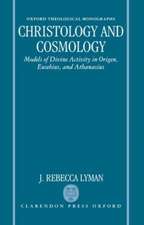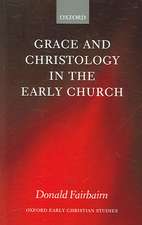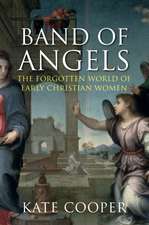Cyprian the Bishop
Autor J. Patout Burns Jr.en Limba Engleză Paperback – 22 noi 2001
It uses cultural anthropology to examine the impact of Cyprian's policy during the Decian persecution. Cyprian attempted to steer the middle ground between compromise and traditionalism and succeeded by defining the boundary between the empire and the church.
J. Patout Burns Jr. concentrates on social structures to reveal the logic of Cyprian's plan, the basis for its success in his time, and why it later failed. This book will be of great interest to classicists, ancient historians and sociologists as well as theologians.
| Toate formatele și edițiile | Preț | Express |
|---|---|---|
| Paperback (1) | 363.78 lei 6-8 săpt. | |
| Taylor & Francis – 22 noi 2001 | 363.78 lei 6-8 săpt. | |
| Hardback (1) | 1006.43 lei 6-8 săpt. | |
| Taylor & Francis – 22 noi 2001 | 1006.43 lei 6-8 săpt. |
Preț: 363.78 lei
Nou
Puncte Express: 546
Preț estimativ în valută:
69.62€ • 72.41$ • 57.47£
69.62€ • 72.41$ • 57.47£
Carte tipărită la comandă
Livrare economică 14-28 aprilie
Preluare comenzi: 021 569.72.76
Specificații
ISBN-13: 9780415238502
ISBN-10: 0415238501
Pagini: 256
Dimensiuni: 138 x 216 x 18 mm
Greutate: 0.31 kg
Ediția:1
Editura: Taylor & Francis
Colecția Routledge
Locul publicării:Oxford, United Kingdom
ISBN-10: 0415238501
Pagini: 256
Dimensiuni: 138 x 216 x 18 mm
Greutate: 0.31 kg
Ediția:1
Editura: Taylor & Francis
Colecția Routledge
Locul publicării:Oxford, United Kingdom
Public țintă
Postgraduate and UndergraduateNotă biografică
J. Patout Burns Jr. is Edward A Malloy Professor of Catholic Studies at Vanderbilt Divinity School. He is the author of The Development of Augustine's Doctrine of Operative Grace, and the editor of Theological Anthropology.
Recenzii
'This study is easily readable. This will make it valuable for students, who will no doubt also appreciate the sober balance of theory and exposition ... the book is ideally suited to an advanced undergraduate course. Burn's work is thoroughly commendable, and the study is recommended without hesitation.' - Augustine Casiday, Reviews in Religion and Theology
'A large part of what makes this book impressive - indeed, of what makes so many of Burns' arguments compelling - is Burns' obvious familiarity with Cyprian's corpus operum. That Burns has dedicated a significant portion of his professional life to the study of Cyprian is something that is evidenced on almost every page and in more than a few of the copious footnotes ... In sum, this book is to be recommended.' - Ephemerides Theologicae Loranieases
'The book is well-written and refreshingly candid about Cyprian's views, without ever seeking to belittle them. It will probably be the standard introduction to his thought for some time to come, and will help to shape the next generation's perception of the important legacy of the North African church.' -Churchman
'A large part of what makes this book impressive - indeed, of what makes so many of Burns' arguments compelling - is Burns' obvious familiarity with Cyprian's corpus operum. That Burns has dedicated a significant portion of his professional life to the study of Cyprian is something that is evidenced on almost every page and in more than a few of the copious footnotes ... In sum, this book is to be recommended.' - Ephemerides Theologicae Loranieases
'The book is well-written and refreshingly candid about Cyprian's views, without ever seeking to belittle them. It will probably be the standard introduction to his thought for some time to come, and will help to shape the next generation's perception of the important legacy of the North African church.' -Churchman
Cuprins
Abbreviations Preface 1.History of Cyprian's Controversies 2.Christians of Carthage under persecution 3.Necessity of repentance 4.Efficacy of the reconciliation ritual 5. Indivisibility of the Church 6.Initiation into Unity 7.Purity of the Church 8.Unity of the Episcopate 9.Cyprian's African heritage Bibliography Indices
Descriere
This is the first up-to-date, accessible study on the rule of Cyprian as the Bishop of Carthage in the 250s AD.
